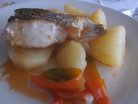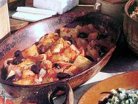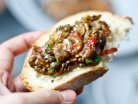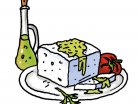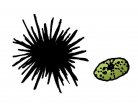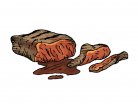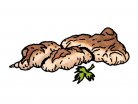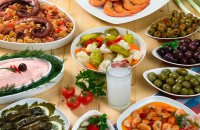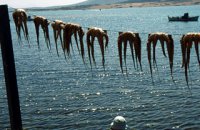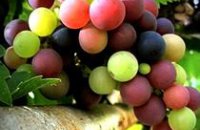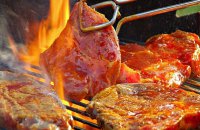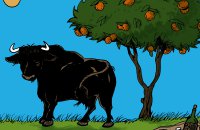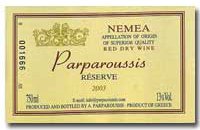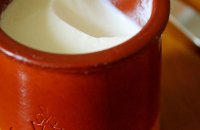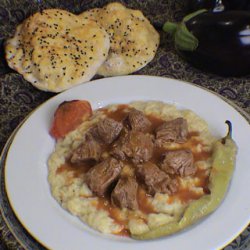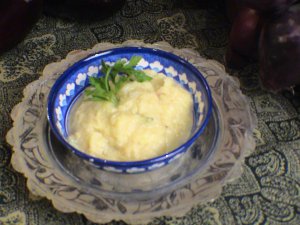The history of modern Turkey began with the arrival of migrants from Central Asia’s Altay Mountains in Anatolia, otherwise known as Asia Minor. These people, the ancestors of the modern Turks, were nomads that depended upon agriculture and the breeding of domestic animals. Their diet was based largely on mutton, goat meat, and beef, and they would prepare their meat in a tandir, an underground oven, or over an open wood or charcoal fire as kebabs. Most of Turkish food is prepared on top of the stove; the oven is hardly used.
One of Turkish cuisine’s traditional staple dishes is kavurma, small cubes of meat cooked in its own fat, salted, and then stored in large earthenware containers, until it is eaten in the winter months. Another traditional delicacy, pastirma, is a preserved meat that is salted, spiced, and dried in the sun. Both of these specialties have survived the onslaught of many centuries, remaining popular dishes still today.
Within the traditional nomadic diet, milk and dairy products played a significant role. The Turkish diet consisted primarily of yoghurt, a product considered today to be the most famous of Turkey’s culinary contributions to international cuisine. Mare’s milk in particular was believed to be far superior to either sheep or cow’s milk; In fact, nutritionists have recently pointed out that mare’s milk has four times the vitamin C content as cow’s milk. Traditionally, nomads would simmer the milk in large shallow pans so as to procure and then consume the cream which rose to the surface and formed a crust. The remaining milk would then be dried in the sun and stored as powder. Not only did milk and thick cream comprise the basic elements of a nomad’s breakfast, but such products would also be fermented to make a strong alcoholic beverage known as kimiz, which is still widely consumed within the region today.
Other basic foods included wheat and barley. Similarly, the product known as bulgar- boiled, dried, and cracked wheat- is still a significant cereal within the Turkish diet. Out of the myriad varieties of bread that the nomads would prepare, yufka ekmek (yufka bread) has historically been the most widespread, and remains so still today. The product is made with a dough of flour, salt, and water, rolled out in round layers, and browned on a thin iron plate, then dried and stored.
Amongst such dishes, one will also find fresh seasonal fruits, and a whole array of dried fruits. Villagers often preserve fruits through drying and sweetening, first soaking the produce in water and molasses made from grape juice. Even with modern advancements in technology and agriculture, many of the methods of food production -preserving, cooking, and baking- have remained unaltered. Most notably, Turkish cuisine has largely resisted the encroachment of fast food, in both the home and in restaurants.
Turkish cooking has been strongly influenced by that of China and Mongolia, with homemade noodles and manti (like tortellini) playing a predominant role atop the Turkish kitchen table. Many other cultures have also left their mark on Turkish cuisine. Arab influences, especially in the south and southeastern parts of Anatolia, have introduced many new spices – hot peppers in particular, while the Persian, Hittite, and Byzantine Empires introduced different vegetables like cabbage, cauliflower, and parsley, among many other ingredients. The combination of meats and fruits that characterize Iranian stews, as well as the different vegetable stews known as yakni, have also made their way into Turkish cuisine. The concept of the “kebab,” one that typifies Turkish cuisine, is of Persian origin. Similarly, the pilav, or pilaf, is the Turkish version of pulau, which is decidedly Persian.
Turkish cuisine was also drastically influenced by that of Greece, primarily in baking. Whereas Central Asia is characterized by its flat breads and pites, Turkey has espoused the round breads that are characteristically Greek. Moreover, the Greek language has permeated much of Turkish cooking terminology, especially with regards to seafood. Today, a wide variety of the ingredients used in Turkish cuisine are still referred to by their Greek names.
During the rise of the Ottoman Empire the culinary arts played an important part in court life, with the richest and most diverse flavors found in dishes prepared during the reign of Sultan Mehmet the Second, who conquered Istanbul in 1453. Beginning with the Seljuqs, Turkey’s cultural forebear, the culinary arts began their gradual rise to greatness. The Seljuqs introduced Anatolia to many new foods, including fruits, vegetables, and herbs, that had been nonexistent in Central Asia. It was not long before these new ingredients began intermingling with the established breads, dough products, and kebabs, thus yielding many new dishes.
By the beginning of the 1700s, the sultan’s kitchen staff encompassed 1.370 people, all of whom were housed within the palace grounds. The preparation of each type of dish (soups, kebabs, pilafs, vegetables, fish, breads, pastries, candy, jams, etc.) was regarded as a separate skill. Alya Algar, in Classical Turkish Cooking, notes that “In 1661, a list showed that 36.000 bushels of rice, 3.000 pounds of noodles, 5000.000 bushels of chickpeas, and 12.000 pounds of salt were used in the palace; and in 1723, the annual meat supply of the palace was 30.000 head of beef, 60.000 of mutton, 20.000 of veal, 200.000 fowl, 100.000 pigeons.”
As time passed, olive oil gradually became an alternative for butter, and sugar replaced honey and grape molasses in desserts. Cumin, coriander, cinnamon, mustard, pepper, and saffron became the dominant spices, while parsley, mint leaves, onions, and garlic became the distinguishing herbs and seasonings.
Modern Turkey is made up of seven regions, each with indigenous agricultural products, cultures, customs, traditions, and local dishes. For example, the majority of desserts made with hazelnuts in the Black Sea area are made in the southeast region of Turkey with pistachios.
Neset Eren summed up Turkish cuisine best in his book The Art of Turkish Cooking: “Many of the well-known national cuisines rely on one basic element. For instance, French cuisine is based on the sauce. Pasta forms the essence of the Italian cuisine. There is however, no single dominant feature in the Turkish kitchen. Meats, fish, vegetables pastries, and fruit are cooked in an infinite variety of ways.”
The History of Turkish Cuisine
Turkish cuisine is the result of the region's seasonal products and a nomadic diet, combined with a variety of influences from the surrounding regions.
Country:
Related Articles
Most Popular recipes
































